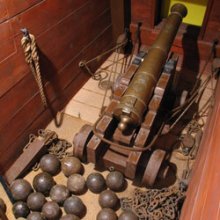
The Defence educational kit presents the archaeological profession as well as artifacts related to defending oneself against an animal or an enemy, engaging in a war or planning a defensive strategy. Uniforms, military structures, spiritual protection, alliances, exchanges and diplomacy as well as hierarchy are also examined.
Educational goals
The Defence educational kit is mainly dedicated to students in the 2nd and 3rd cycles in elementary school as well as to high school students. The goal of the educational kits is to introduce students to the discipline of archaeology and to explain, through a thematic selection of artifacts, the lifeways of the different peoples who have occupied this territory. The subjects broached are in line with those addressed by the Quebec Education Program.
Our educational kits were created in order to support students’ learning and the development of the following competencies.
In the field of Social sciences, elementary school students in Cycles Two and Three learn to:
1) Understand the organization of a society in its territory
- Identifying traces left by a society
- Determining location
- Identifying features of a society’s adaptation to its territory
- Establishing the geographic and historic contexts of a society
2) Interpret changes in a society and in its territory
- Recognizing changes in the boundaries of a territory
- Identifying the causes and consequences of changes
3) Become open to the diversity of societies and their territories
- Describing similarities and differences in the organization of various societies and their territories
In the field of Science and technology, students are asked to make use of tools and objects and to apply the procedures of science and technology. Every ordinary object, from pocket-knife to bicycle, has a lengthy history that can tell us a great deal about the curiosity, tenacity and imagination of human beings. Our workshops encourage objectivity, rigour and precision.
In the new elementary program, teaching is accomplished through various approaches, including the guidance-oriented approach. This approach is designed to present different occupational fields, encourage the development of personal qualities (for example, creativity, self-confidence, tenacity, audacity, self-knowledge) and foster the ability to choose. The approach is based on students’ involvement in diverse projects and, at the same time, gives students an understanding of the world of work, ownership of a project, etc. The presence of an archaeologist in the classroom is an important asset in the context of this approach.
Specific goals of the Defence educational kit:
- Knowledge of the spatial-temporal framework discussed
- Understanding the terms “artifact”, “ecofact”, “immovable remains”, and “stratigraphy”
- Knowledge of the methods of analyzing an artifact
- Classifying an artifact according to its main characteristics
- Associating an artifact to one of the peoples studied in class
- Analyzing the different characteristics of an artifact
- Explaining the lifeways of the different peoples studied through a theme
- Knowledge of archaeological sites and interpretation centers
